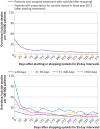Associations between stopping prescriptions for opioids, length of opioid treatment, and overdose or suicide deaths in US veterans: observational evaluation
- PMID: 32131996
- PMCID: PMC7249243
- DOI: 10.1136/bmj.m283
Associations between stopping prescriptions for opioids, length of opioid treatment, and overdose or suicide deaths in US veterans: observational evaluation
Abstract
Objective: To examine the associations between stopping treatment with opioids, length of treatment, and death from overdose or suicide in the Veterans Health Administration.
Design: Observational evaluation.
Setting: Veterans Health Administration.
Participants: 1 394 102 patients in the Veterans Health Administration with an outpatient prescription for an opioid analgesic from fiscal year 2013 to the end of fiscal year 2014 (1 October 2012 to 30 September 2014).
Main outcome measures: A multivariable Cox non-proportional hazards regression model examined death from overdose or suicide, with the interaction of time varying opioid cessation by length of treatment (≤30, 31-90, 91-400, and >400 days) as the main covariates. Stopping treatment with opioids was measured as the time when a patient was estimated to have no prescription for opioids, up to the end of the next fiscal year (2014) or the patient's death.
Results: 2887 deaths from overdose or suicide were found. The incidence of stopping opioid treatment was 57.4% (n=799 668) overall, and based on length of opioid treatment was 32.0% (≤30 days), 8.7% (31-90 days), 22.7% (91-400 days), and 36.6% (>400 days). The interaction between stopping treatment with opioids and length of treatment was significant (P<0.001); stopping treatment was associated with an increased risk of death from overdose or suicide regardless of the length of treatment, with the risk increasing the longer patients were treated. Hazard ratios for patients who stopped opioid treatment (with reference values for all other covariates) were 1.67 (≤30 days), 2.80 (31-90 days), 3.95 (91-400 days), and 6.77 (>400 days). Descriptive life table data suggested that death rates for overdose or suicide increased immediately after starting or stopping treatment with opioids, with the incidence decreasing over about three to 12 months.
Conclusions: Patients were at greater risk of death from overdose or suicide after stopping opioid treatment, with an increase in the risk the longer patients had been treated before stopping. Descriptive data suggested that starting treatment with opioids was also a risk period. Strategies to mitigate the risk in these periods are not currently a focus of guidelines for long term use of opioids. The associations observed cannot be assumed to be causal; the context in which opioid prescriptions were started and stopped might contribute to risk and was not investigated. Safer prescribing of opioids should take a broader view on patient safety and mitigate the risk from the patient's perspective. Factors to address are those that place patients at risk for overdose or suicide after beginning and stopping opioid treatment, especially in the first three months.
© Author(s) (or their employer(s)) 2019. Re-use permitted under CC BY-NC. No commercial re-use. See rights and permissions. Published by BMJ.
Conflict of interest statement
Competing interests: All authors have completed the ICMJE uniform disclosure form at www.icmje.org/coi_disclosure.pdf and declare: support from the Veterans Affairs Office of Mental Health Suicide Prevention for the submitted work; JMH received support from grants from the Office of the Director, National Institutes of Health (grant R01DA045027); SK owns stock in CVS Health, Thermo Fisher Scientific, and Zimmer Biomet, not exceeding 5% of his assets; he also personally owned stock in two pharmaceutical companies (Abbott and Merck) before 31 December 2017, which amounted to less than 5% of his assets, and were sold before the end of 2017. SK’s spouse personally owns stock in Abbott, Merck, and Johnson & Johnson, not exceeding 10% of her assets. SK has offered opinions in the peer reviewed and lay literature on the ethics of non-consensual or suddenly stopping opioids in patients with pain. All other authors declare no financial relationships with any organizations that might have an interest in the submitted work in the previous three years, and no other relationships or activities that could appear to have influenced the submitted work.
Figures

Comment in
-
Increased risk of death by suicide or overdose in patients stopping opioid medications.Evid Based Nurs. 2021 Oct;24(4):137. doi: 10.1136/ebnurs-2020-103293. Epub 2020 Aug 31. Evid Based Nurs. 2021. PMID: 32868481 No abstract available.
References
-
- Martins SS, Sarvet A, Santaella-Tenorio J, Saha T, Grant BF, Hasin DS. Changes in US lifetime heroin use and heroin use disorder: prevalence from the 2001-2002 to 2012-2013 National Epidemiologic Survey on Alcohol and Related Conditions. JAMA Psychiatry 2017;74:445-55. 10.1001/jamapsychiatry.2017.0113 - DOI - PMC - PubMed
-
- St Amour M. Central Maine patients fear weaning off opioids as they struggle with chronic pain. 21 January 2017. https://www.centralmaine.com/2017/01/21/central-maine-patients-fear-medi...
Publication types
MeSH terms
Substances
Grants and funding
LinkOut - more resources
Full Text Sources
Medical
